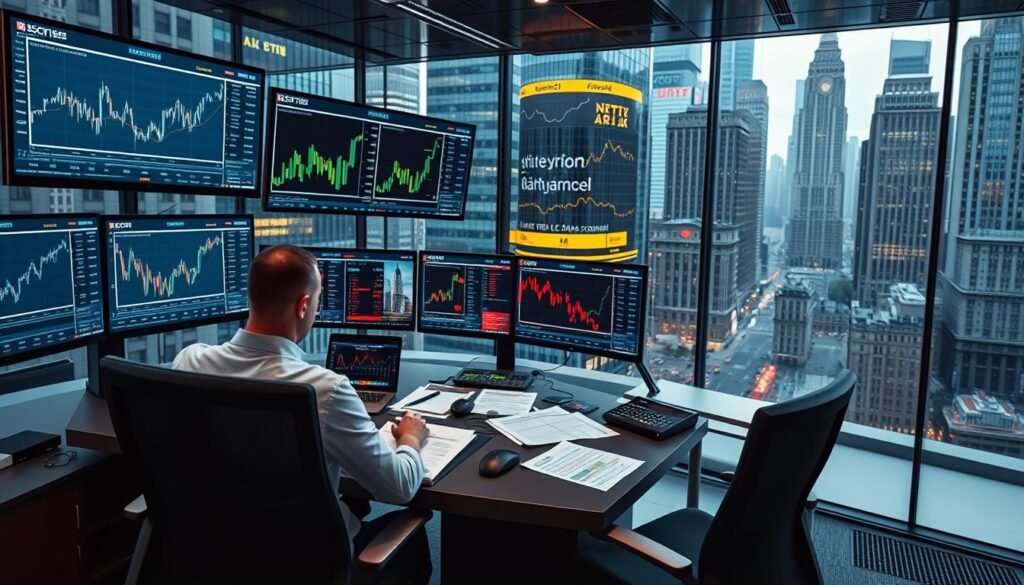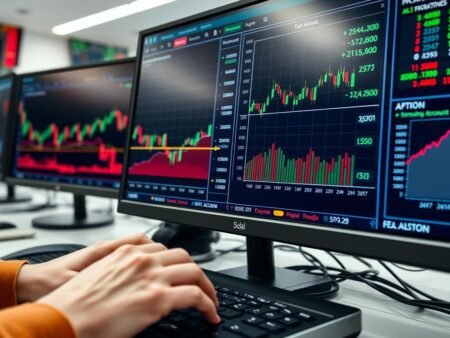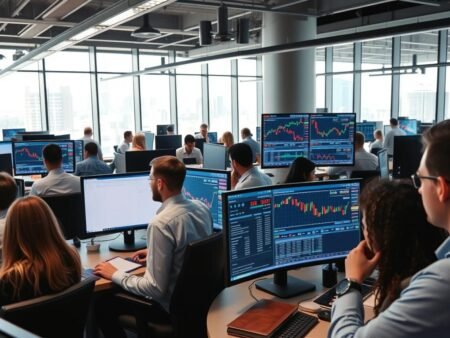Ever wondered how top traders at proprietary firms stay calm with huge sums of their company’s money? They use a strict approach to risk management in prop trading to stay profitable. This section shows the key strategies these pros use to succeed in finance.
Trading for a prop firm is more than just predicting market trends. It’s about mastering prop firm trading risk management. Prop traders make choices that balance risk and reward, using the firm’s money. Knowing how to manage risk is crucial in this fast-paced world.
Expert traders know that managing risk is key to keeping capital safe and making profits. Without a solid risk management plan, even the best traders can face huge losses. This section introduces expert tips to protect a prop trader’s career and the firm’s finances.
Key Takeaways
- Importance of a disciplined approach to risk management for prop traders.
- The dual focus on capital preservation and profit maximization in prop trading.
- Insights into the responsibilities and strategies used by successful prop firm traders.
- Understanding that effective risk management can significantly impact both the trader and the firm’s long-term success.
- Preview of expert risk management tips designed to navigate the complex trading landscape of a proprietary firm.
Understanding the Basics of Prop Trading Risk Management
Learning about risk management in proprietary trading is key for new and seasoned traders. Good risk strategies keep your finances safe and promote disciplined trading. This part explains why a solid risk plan is vital and covers important concepts for traders.
The Importance of a Solid Risk Management Plan
In proprietary trading, managing uncertainty is linked to long-term success. A strong risk management plan is essential. It includes thorough risk assessments at each trading stage, helping traders make smart choices and protect their capital from market surprises.
Key Risk Management Terms Every Prop Trader Should Know
Traders must understand specific risk management terms to handle market complexities. Key terms include “drawdown,” which shows a portfolio’s decline from its peak, “value at risk (VaR),” a tool for estimating potential losses, and “stop-loss orders,” which limit losses. These terms are crucial for effective risk control.
- Drawdown: Helps measure an investment’s potential loss after peak performance.
- Value at Risk (VaR): Assesses the maximum potential loss over a specified time frame at a given confidence interval.
- Stop-loss orders: Automatically sells a security when it reaches a certain price, thus preventing further losses.
Knowing these terms helps in proactive risk management. It also improves strategic planning and decision-making in different market conditions.
How to Manage Risk When Trading for a Prop Firm
Managing risks well is key to lasting success and profit in prop trading. It’s all about prop trading risk mitigation strategies. These help traders stay ready and proactive against market ups and downs.
To understand how to manage risk when trading for a prop firm, it’s not just about cutting losses. It’s also about making the most of gains. Here’s how to do it right:
- Diversify assets to spread out risk
- Use strict risk/reward ratio benchmarks
- Keep reviewing and adjusting based on market changes and performance
Traders must also work on their mental game. They need discipline, patience, and objectivity. This helps them stay focused in unpredictable trading times.
| Strategy | Description | Impact |
|---|---|---|
| Risk/Reward Ratio Setting | Set clear entry and exit points to maximize gains and limit losses. | Improves decision-making and reduces emotional trading. |
| Market Trend Analysis | Regularly analyze market trends to adjust strategies. | Boosts response to market changes and threats. |
| Asset Diversification | Invest in different asset classes to reduce risks from any single market. | Lessens systemic risks and smooths out returns. |
By adopting these strategies and staying updated with market news and prop trading methods, traders can greatly improve their risk management skills in a prop trading firm.
Establishing Your Risk Management Strategy
Creating a strong risk management plan for prop trading starts with knowing your risk tolerance. It also means setting trading rules that focus on steady growth and safety. Good risk monitoring helps by matching your trading with your risk level and the market.
Assessing Your Risk Tolerance
Starting with a personal risk check is key. Knowing how much risk you can handle is vital. It helps in making a strategy you can stick to, avoiding emotional trading decisions.
Defining Your Risk Management Parameters
Turning your risk tolerance into numbers means setting clear rules. These include daily loss limits, maximum drawdown, and trade size limits. These rules help keep your trading in line with your risk and goals.
Using these rules helps keep your trading disciplined. It’s also important to adjust them as the market or your goals change.
| Risk Parameter | Description | Example |
|---|---|---|
| Daily Loss Limit | Maximum amount that can be lost in one day | $500 |
| Maximum Drawdown | Maximum acceptable peak-to-trough decline in account value | 20% |
| Trade Size | Maximum portion of capital utilized per trade | 2% per trade |
Tools and Techniques for Effective Risk Control in Prop Trading
In prop trading, knowing how to manage risk is key. You need the right tools and techniques. Advanced tools help understand complex markets and let traders use strong risk strategies.
Technical indicators are crucial for trading. They give data that can be tested against past markets. This helps traders make better choices. For instance, volatility indicators help find the best times to buy or sell, lowering risk from market changes.
Risk management software is also vital. It watches and analyzes risks in positions and portfolios. It helps with planning for unexpected market situations.
- Scenario Analysis Tools: These predict outcomes under different financial or economic conditions. They help traders plan against market uncertainties.
- Stress Testing Programs: These tools test portfolios under extreme but possible scenarios. They ensure traders can handle volatile markets.
Using these tools well helps traders stay ahead of market changes. Knowing how to use them is crucial for good risk management in prop trading.
The goal is to mix analytical tools with good trading practices. This creates a strong risk management plan. It helps limit losses and increase profits by using market insights and data analysis.
Building a Proprietary Risk Assessment Model
In the world of proprietary trading, creating a custom risk model is key. This part talks about the difference between quantitative and qualitative risk assessments. It also shows how to mix them into strong risk models to better manage prop trading risks.
Quantitative vs Qualitative Risk Assessment
Quantitative risk assessment uses stats and math to predict losses based on past data. It’s valued for being clear and precise. On the other hand, qualitative risk assessment relies on expert opinions and market feelings. It looks at things that can’t be measured.
By using both, traders get a full picture of the risks they face.
Integrating Market Analysis into Risk Models
Prop trading risk control needs to keep up with market changes. Adding real-time market analysis to risk models helps traders adjust quickly. This makes it easier to avoid big losses before they happen.
| Feature | Quantitative Assessment | Qualitative Assessment |
|---|---|---|
| Focus | Historical data and statistical models | Expert judgment and market sentiment |
| Benefits | Precision in risk quantification | Flexibility in assessing non-quantifiable risks |
| Integration in Models | Rigid, based on existing data trends | Adaptive, considering current market contexts |
Using both methods makes risk management better. It helps prop trading desks handle risks more effectively. By understanding and using both, traders can control risks better. This leads to more safety and profit in changing markets.

Incorporating Prop Trading Risk Mitigation Tactics
Prop trading risk mitigation is key in today’s financial markets. Traders need good strategies to protect their investments and make money. This part talks about tactics to manage risk well.
Good risk management in prop trading means using smart strategies. These include hedging, correlation trading, and portfolio insurance. Each one helps lower losses and grab market chances.
- Hedging with derivatives: This method uses options and futures to protect against losses in your portfolio.
- Correlation trading: It’s about trading assets that move together. This way, not all investments will lose value at once.
- Portfolio insurance: Stop-loss orders or put options act as insurance against big losses in your portfolio.
Let’s look at how these strategies work in real life:
| Strategy | Advantages | Common Applications |
|---|---|---|
| Hedging with Derivatives | Limits potential losses, allows for leverage | Futures and options used in volatile markets |
| Correlation Trading | Reduces risk through portfolio diversification | Pair trading in equities and forex |
| Portfolio Insurance | Prevents large-scale financial damage during downturns | Use of dynamic hedging techniques |
To use these strategies well, you need to know the market and the tools. Traders must keep learning and adjusting their plans as the market changes.
In short, managing risk in prop trading is about protecting your assets and growing as a trader. By using these strategies, prop traders can stay profitable and successful over time.
Determining Proper Position Sizing and Leverage
In the world of proprietary trading, knowing how to manage risk is key. This part talks about finding the right position sizes and leverage. It helps traders do well while keeping their risks in check.
Calculating Position Sizes for Optimal Risk Management
Position sizing is vital for prop traders. It’s about how much money to risk on one trade compared to your total capital. This approach keeps risks low and returns high. It’s all about finding a balance.
Traders should not risk too much or too little. They can learn more about this by visiting top prop trading sites. These sites offer tools and insights for managing risk.
Understanding the Impact of Leverage on Trading Risks
Leverage can make profits bigger, but it can also increase losses. It’s a powerful tool that needs careful handling. Traders must know their risk limits and use leverage wisely.
This careful balance is key for success in prop trading. It helps traders avoid big losses and stay in the game for the long haul.
By following strict risk management rules, like position sizing and controlled leverage, prop traders can lower their risks. They can also increase their chances of making money. It’s important for traders to keep learning about leverage and position sizing.
Developing Robust Risk Monitoring Systems
In today’s fast-paced prop trading world, having good risk monitoring systems is key. These systems track and analyze risks, helping traders act fast when market conditions change.
Real-time Monitoring Tools for Prop Traders
Prop traders use real-time tools to stay ahead and manage risks. These tools give instant updates on market changes, helping traders make fast, smart choices. This is crucial for keeping losses low and making the most of gains.
Setting Up Alerts and Triggers for Risk Events
Setting up alerts and triggers is also crucial. These notifications let traders act fast when risks pop up, avoiding big financial hits. By setting alerts based on risk levels, trading stays within safe limits.
Good risk monitoring also means having strong communication systems. This keeps everyone in the loop during risky times. It makes monitoring better and strengthens the trading firm’s risk management.
| Feature | Benefit |
|---|---|
| Real-time Market Data | Enables quick decision-making and immediate reaction to market events. |
| Automated Risk Alerts | Ensures traders and risk managers are promptly informed about potential risk breaches. |
| Collaborative Tools Integration | Fosters teamwork in managing complex risk scenarios effectively. |
By improving these tools and strategies, prop trading firms protect their assets and get ahead in trading. Keeping risk management systems up to date is vital for success and growth.
Implementing Stop Loss and Take Profit Strategies
Effective prop trading risk strategies are key to making money and keeping losses small in the fast-changing world of proprietary trading. At the heart of these strategies are stop loss and take profit orders. They are crucial for managing risks well.
These strategies automatically close trades at set prices to protect profits or limit losses. They can greatly change a trader’s risk level. This can mean the difference between making money and losing it.
To use these tools, you need to understand the market and know your limits. Here’s how to use them well:
- Find realistic prices for stopping losses or taking profits based on your analysis and goals.
- Keep checking and adjusting these prices as the market changes or news comes out.
- Use tools like moving averages and support levels to set smart price points for stop loss and take profit orders.
Adjusting these orders is key to prop trading risk strategies. For example, a cautious trader might set tight stops to avoid small losses. A bold trader might let prices move more before closing the trade.
| Strategy Type | Risk Level | Typical Use Case |
|---|---|---|
| Tight Stop Loss | Low | High-volatility trading where minimizing potential loss is prioritized over larger gains. |
| Loose Stop Loss | High | Markets with higher predictability and lower volatility, allowing more space for profit maximization. |
Using these orders in your trading helps control risks and builds discipline. Trading on autopilot based on plans can prevent emotional decisions. This is a common trap for many traders.
Getting the most out of stop loss and take profit orders is about finding the right balance. This balance should match your market view, risk level, and trading goals. This shows the essence of prop trading risk strategies.
The Role of Psychology in Prop Trading Risk Management
In prop trading, psychology is key to managing risks. Knowing how emotions affect trading and staying disciplined are crucial. These skills help traders handle market ups and downs better.
Recognizing Emotional Triggers and Biases
Feelings like fear of missing out (FOMO) or panic selling can ruin good trading plans. Biases, like being too sure of oneself, might lead traders to ignore important risk control steps. It’s important for traders to know these psychological factors and how they can affect their trading.
Maintaining Discipline in High-Risk Trading Scenarios
Staying disciplined is essential for success in proprietary trading. High-pressure situations can make traders stray from their plans, increasing risks. Regular training and sticking to risk limits help keep a disciplined trading mindset.
Here are some common psychological challenges and how to stay disciplined:
| Psychological Challenges | Strategies for Discipline |
|---|---|
| Fear of Loss | Adherence to stop-loss orders |
| Excessive Optimism | Rigorously test assumptions |
| Desire for Quick Profits | Focus on long-term goals |
| Reaction to Market Noise | Strong reliance on data over speculation |

Leveraging Technology for Enhanced Prop Trading Risk Control
In the fast-paced world of proprietary trading, technology is key. It boosts prop trading risk control and prop trading risk monitoring. Advanced software and algorithms help traders predict risks and control them automatically. This makes trading safer and more profitable.
Automated Risk Management Software
Automated risk management tools are essential for prop trading firms. They support daily trading by evaluating risks in real-time. This lets traders make quick, accurate decisions, keeping strategies safe and assets secure.
Utilizing AI and Machine Learning for Risk Predictions
AI and machine learning have changed prop trading risk monitoring. They predict market changes with great accuracy. These technologies look at huge datasets to spot patterns humans miss. This helps traders manage risks before they happen.
| Feature | Impact on Prop Trading |
|---|---|
| Real-Time Data Analysis | Enables faster decision-making and immediate risk assessment |
| Pattern Recognition | Helps in the identification of profitable trading signals and risk factors |
| Automated Alerts | Reduces response time to potential risks, improving overall trade safety |
| Predictive Analytics | Forecasts market trends to adjust strategies for potential future scenarios |
Using these technologies in prop trading improves prop trading risk control. It also helps traders understand and prepare for market changes. This leads to a stronger trading framework.
Maintaining Compliance with Firm and Regulatory Risk Requirements
In the world of proprietary trading, following both firm and regulatory rules is a must. Prop trading risk management means sticking to standards that protect traders and firms. Breaking these rules can cause big problems, like fines and losing the right to trade. So, it’s key to know and follow strict compliance rules.
For those in prop trading risk assessment, knowing the latest rules and changes is crucial. Rules change with the market and new financial issues. Staying up-to-date with these changes helps keep trading legal and within bounds.
Prop trading firms also have their own risk rules, besides the law. These rules help manage risks specific to their trading and operations. Following these rules is just as important as following the law.
| Compliance Area | Description | Impact |
|---|---|---|
| Regulatory Adherence | Compliance with financial regulation authorities | Prevents legal issues and enhances market integrity |
| Firm-Specific Protocols | Internal rules set by the prop trading firm | Aligns trader activities with firm’s strategic objectives |
| Continuous Education | Ongoing training on risk management practices | Ensures traders are updated on latest risk mitigation techniques |
To deal with both outside and inside rules, constant learning and a deep understanding of prop trading risk management are vital. Firms need to offer regular training and resources for traders to stay informed and follow rules. This mix of smart traders and strong rules leads to a safe and successful trading space.
Continuous Education: Staying Updated with Risk Management Practices
In the fast-changing world of proprietary trading, effective risk management for prop traders is key. It requires constant learning and adapting. By learning from others and sharing ideas, traders can better predict and avoid risks.
Participating in Risk Management Training Programs
Formal risk management training is crucial for prop traders. These programs teach a variety of strategies. They cover basic and complex risk management concepts.
Traders learn about scenario analysis and how to balance risks and rewards. This knowledge is vital for prop trading risk strategies.
Networking with Other Prop Traders for Shared Learning
Networking is vital for staying ahead in trading. It lets traders share experiences and strategies. This sharing enhances knowledge about effective risk management for prop traders.
By working together, traders can create stronger risk management plans. These plans can adapt to market changes.
Continuing education in risk management is essential. It keeps traders informed and reduces risks. From workshops to webinars, traders need to find the right resources for their growth.
Creating a Risk Management Checklist for Daily Trading Routine
For those in prop trading, managing risk daily is key, not just a good idea. A routine that checks for risks helps your trading run smoothly. It makes risk management a big part of your trading life. Here’s how to make your day more precise and aware.
Risk Checklist Before Market Open
Before the market opens, a careful check helps start the day with less risk. This checklist looks at things that could change your trading plans and risk levels.
- Review overnight market changes and news that could affect your trading instruments.
- Evaluate the economic calendar for market-moving events and announcements.
- Check for any system updates or issues that could affect trading execution.
- Assess your current positions and adjust your strategy based on pre-market conditions.
- Ensure all risk management tools and processes are operational and set according to the day’s strategy.
Post-Trading Session Risk Review
After the market closes, it’s important to look back at your trades and risk management. This review helps improve your strategies and get ready for the next day.
- Analyze if the day’s trading met your expected outcomes based on your risk parameters.
- Identify any deviations from the planned risk management strategy and understand the reasons behind them.
- Review and adjust your risk thresholds as necessary, based on the day’s trading data and market conditions.
- Record insights and anomalies to prepare for similar future scenarios, enhancing your prop trading risk assessment accuracy.
Adding these checklists to your daily routine makes risk management a constant process. It keeps up with market changes and your trading mindset. Remember, using these practices regularly and updating them often is key to mastering risk management in prop trading.
Handling Extreme Market Events and Black Swan Risks
In prop trading, managing risks is not just about dealing with daily market changes. It also means being ready for rare and big events. These events, known as Black Swans, are rare and have a big impact. They require special strategies to handle them.
Creating detailed plans for before, during, and after these events is key. This helps prop traders stay on track and protect their investments.
Liquidity management is crucial in these unpredictable times. Prop traders need enough liquidity to make quick trades or keep operations going during tough times. Being able to quickly change strategies shows a trader’s risk plans are strong.
This proactive approach helps protect traders from unexpected events. It also helps the firm avoid long-term financial problems.
Being mentally prepared is also important for dealing with Black Swan events. These events can cause stress and lead to quick, possibly wrong decisions. Having a strong mindset helps traders stay calm and make clear plans.
Preparing for extreme events is all about being ready for the unexpected. It shows prop traders are adaptable and resilient. This is the heart of good risk planning.












